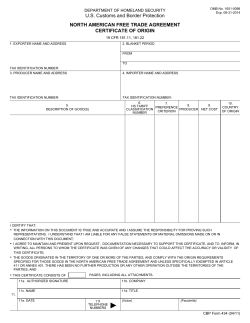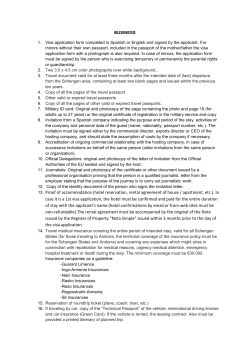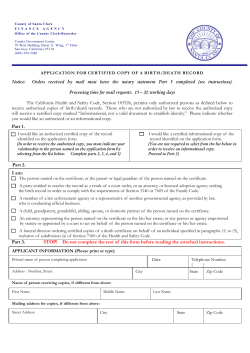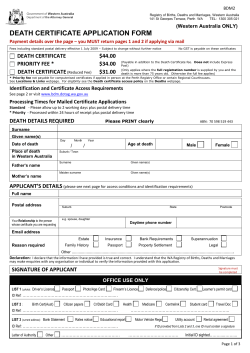
CERTIFICATE OF ORIGIN Canada-Peru Free Trade Agreement (instructions on reverse) PROTECTED
Restore
Instructions (English)
CERTIFICATE OF ORIGIN
Canada-Peru Free Trade Agreement
(instructions on reverse)
PROTECTED (when completed) B
Please print or type
1. Exporter's name and address:
Help
2. Blanket period:
Telephone:
Fax:
Y
M
D
From:
Y
M
D
To:
E-Mail:
3. Producer's name and address:
4. Importer's name and address:
Telephone:
Fax:
E-Mail:
Telephone:
Fax:
E-Mail:
5.
Description of good(s)
6. HS tariff
7. Preference
classification no.
criterion
8.
Producer
9. Value
Test
10. Country
of origin
11. Reference Number:
12. Observations:
13. I certify that:
- The information in this document is true and accurate and I assume the responsibility for proving such representations. I understand that I am liable for any
false statements or material omissions made on or in connection with this document.
- I agree to maintain, and present upon request, documentation necessary to support this Certificate, and to inform, in writing, all persons to whom the
Certificate was given of any changes that would affect the accuracy or validity of this Certificate.
- The goods originate in the territory of one or both Parties and comply with the origin requirements specified for those goods in the Canada - Peru Free
Trade Agreement.
This Certificate consists of
pages, including all attachments.
Authorized signature:
Company:
Name:
Title:
Date
BSF267 E
Y
M
D
Telephone:
E-mail:
Fax:
Instructions for Completing the Certificate of Origin
For purposes of obtaining preferential tariff treatment, this document must be completed legibly and in full by the exporter and be in the
possession of the importer at the time the declaration is made. This document may also be completed voluntarily by the producer for use by the
exporter. Please print or type. If more space is needed, please use additional pages.
Field 1: State the full legal name, address (including city and country), telephone number, fax number and e-mail address of the exporter.
Field 2: Complete this Field if the Certificate covers multiple shipments of identical goods as described in Field 5 that are imported into Canada or Peru for
a specified period of up to 12 months (blanket period). "FROM" is the date upon which the Certificate becomes applicable to the good covered by
the blanket Certificate (it may be earlier than the date this Certificate is signed). "TO" is the date upon which the blanket period expires. The
importation of a good for which preferential tariff treatment is claimed based on this Certificate must occur between these dates.
Field 3: If one producer, state the full legal name, address (including city and country), telephone number, fax number and e-mail address, of said
producer. If more than one producer is included on the Certificate, state "VARIOUS" and attach a list of all producers, including their legal names,
addresses (including city and country), telephone numbers, fax numbers and e-mail addresses, cross-referenced to the good(s) described in Field
5. If you wish this information to be confidential, it is acceptable to state "AVAILABLE TO AUTHORITY UPON REQUEST".
Field 4: State the full legal name, address (including city and country), telephone number, fax number and e-mail address of the importer.
Field 5: Provide a full description of each good. The description should contain sufficient detail to relate it to the invoice description and to the Harmonized
System (HS) description of the good. If the Certificate covers a single shipment of a good, it should list the quantity and unit of measurement of
each good, including the series number, if possible.
Field 6: For each good described in Field 5, identify the HS tariff classification to six digits.
Field 7: For each good described in Field 5, state which criterion (A through D) is applicable. The rules of origin are contained in Chapter Three (Rules of
Origin) and Annex 301 (Specific Rules of Origin). NOTE: In order to be entitled to preferential tariff treatment, each good must meet at least one of
the criteria below.
Preference Criteria
A
The good is "wholly obtained or produced entirely" in the territory of one or both of the Parties, as referred to in Article 318. NOTE: The purchase
of a good in the territory does not necessarily render it "wholly obtained or produced entirely". (Reference: Articles 301(a) and 318)
B
The good is produced entirely in the territory of one or both of the Parties and satisfies the product specific rule of origin, set out in Annex 301 that
applies to its tariff classification. The rule may include a change in tariff classification or a change in tariff classification plus a value test. The good
must also satisfy all other applicable requirements of Chapter Three (Reference: Article 301(b)).
C
The good is produced entirely in the territory of one or both of the Parties exclusively from originating materials. Under this criterion, one or more
of the materials may not fall within the definition of "wholly obtained or produced entirely", as set out in Article 318. All materials used in the
production of the good must qualify as 'originating" by meeting the rules of origin of Article 301 (a) through (d). (Reference: Article 301(c))
D
The good is produced entirely in the territory of one or both of the Parties but does not meet the applicable rule of origin, set out in Annex 301
because certain non-originating materials do not undergo the required change in tariff classification. The good does nonetheless satisfy the value
test specified in Article 301(d). This criterion is limited to the following circumstance: the good incorporates one or more non-originating materials
which cannot undergo a change in tariff classification because both the good and the non-originating materials are classified in the same
subheading, or heading that is not further subdivided into subheadings.
NOTE: This criterion does not apply to goods of Chapters 01 through 21, headings 39.01 through 39.15 or Chapters 50 through 63 of the HS.
(Reference: Article 301(d)).
Field 8: For each good described in Field 5, state "YES" if you are the producer of the good. If you are not the producer of the good, state "NO" followed
by (1), (2) or (3), depending on whether this Certificate was based upon:
(1) your knowledge of whether the good qualifies as an originating good;
(2) your reliance on the producer's written representation (other than a Certificate of Origin) that the good qualifies as an originating good; or
(3) a completed and signed Certificate for the good voluntarily provided to the exporter by the producer.
Field 9: For each good described in Field 5, where the good is subject to a value test, indicate "NC" if the value test is based on the net cost or "TV" if the
value test is based on the transaction value. If the value test is based on the net cost of the good over a period of time, further identify the
beginning and ending dates (YYYY/MM/DD) of that period. (Reference: Article 303)
Field 10:
Identify the name of the country of origin ("PE" for all originating goods exported to Canada; "CA" for all originating goods exported to Peru).
Field 11:
If the Certificate covers a single shipment of a good, list the invoice number as shown on the commercial invoice. If not known, indicate another
unique reference number, such as the purchase order number, shipping order number or any other number that can be used to identify the goods.
Field 12:
This Field may be used when there is some observation relating to this Certificate, such as, when the good or goods described in Field 5 have
been subject to an advance ruling or a ruling on the classification or value of materials. Indicate the issuing authority, the reference number, and
the date of issuance.
Field 13:
This Field must be completed, signed and dated by the exporter. When the Certificate is completed by the producer for use by the exporter, it
must be completed, signed and dated by the producer. The date must be the date the Certificate was completed and signed.
© Copyright 2025





















